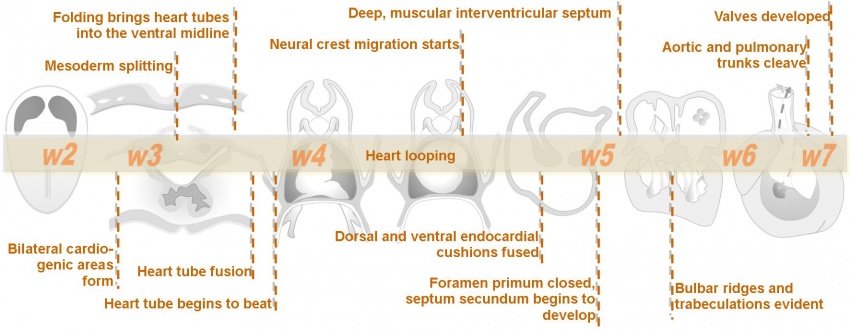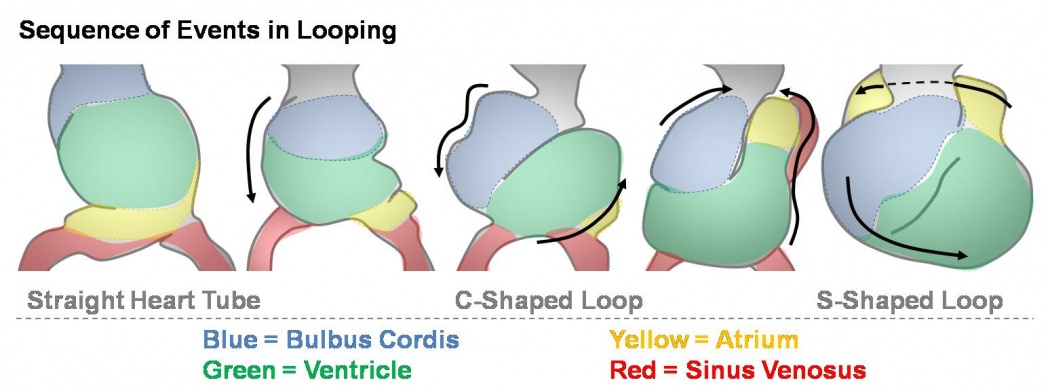Intermediate - Heart Tube Looping: Difference between revisions
No edit summary |
No edit summary |
||
| Line 8: | Line 8: | ||
Looping of the heart tube allows the straight heart tube to form a more complex structure | Looping of the heart tube allows the straight heart tube to form a more complex structure reminiscent of the adult heart. Most cardiac looping occurs during the fourth week and completes during the fifth week of development. The steps in looping can be summarised as: | ||
#The straight heart tube begins to elongate with simultaneous growth in the '''bulbus cordis''' and '''primitive ventricle'''. | #The straight heart tube begins to elongate with simultaneous growth in the '''bulbus cordis''' and '''primitive ventricle'''. | ||
#This forces the heart to bend ventrally and rotate to the right forming a C-shaped loop with convex side situated on the right. | #This forces the heart to bend ventrally and rotate to the right, forming a C-shaped loop with convex side situated on the right. | ||
#The ventricular bend moves caudally and the distance between the outflow and inflow tracts diminishes. | #The ventricular bend moves caudally and the distance between the outflow and inflow tracts diminishes. | ||
#The atrial and outflow poles converge and myocardial cells are added forming the '''truncus arteriosus'''. | #The atrial and outflow poles converge and myocardial cells are added, forming the '''truncus arteriosus'''. | ||
Hence | Hence an S-shape is formed with the first bend of the 'S' being the large ventricular bend while the bend at the junction of the atrium and sinus venosus forms the second 'S' bend. | ||
The following animation portrays these concepts from the traditional, ventral view of the heart. You can also view this animation from a lateral [[Intermediate_-_Heart_Tube_Looping_2|left]] or [[Intermediate_-_Heart_Tube_Looping_3|right]] view. | The following animation portrays these concepts from the traditional, ventral view of the heart. You can also view this animation from a lateral [[Intermediate_-_Heart_Tube_Looping_2|left]] or [[Intermediate_-_Heart_Tube_Looping_3|right]] view. | ||
| Line 25: | Line 25: | ||
[[Image:HeartILP_draft_loopingseries.jpg|thumb|center|upright=3.5|Movement of the parts of the heart tube during looping]] | [[Image:HeartILP_draft_loopingseries.jpg|thumb|center|upright=3.5|Movement of the parts of the heart tube during looping]] | ||
The following scanning electron micrographs illustrate the same morphological changes in the heart tube described above. The straight heart tube can be seen to form a C-shape, with the convex bulge on the right side of the embryo representing much of the expansive conotruncus and right ventricle. By day 25 | The following scanning electron micrographs illustrate the same morphological changes in the heart tube described above. The straight heart tube can be seen to form a C-shape, with the convex bulge on the right side of the embryo representing much of the expansive conotruncus and right ventricle. By day 25 it is possible to see the early formation of the S-shaped loop where the left-sided predominant bulge indicates the left ventricle and the atrium and sinus venosus have moved dorsally. | ||
[[Image:HeartILP_draft_SEMseries.jpg|thumb|center|upright=4.5|Series of scanning EMs showing the rapid change in the appearance of the heart tube]] | [[Image:HeartILP_draft_SEMseries.jpg|thumb|center|upright=4.5|Series of scanning EMs showing the rapid change in the appearance of the heart tube]] | ||
Note that previously | Note that previously the heart was attached to the dorsal '''pericardial wall''' by the '''dorsal mesocardium'''. During heart looping, the dorsal mesocardium degenerates, forming the '''transverse pericardial sinus''' (a point of communication across the pericardial coelom). | ||
Revision as of 12:34, 6 November 2009
| Begin Intermediate: | Primordial Heart Tube | Heart Tube Looping | Atrial Ventricular Septation | Outflow Tract | Heart Valves | Cardiac Abnormalities | Vascular Overview |
| Cardiac Embryology | Begin Basic | Begin Intermediate | Begin Advanced |
Looping of the heart tube allows the straight heart tube to form a more complex structure reminiscent of the adult heart. Most cardiac looping occurs during the fourth week and completes during the fifth week of development. The steps in looping can be summarised as:
- The straight heart tube begins to elongate with simultaneous growth in the bulbus cordis and primitive ventricle.
- This forces the heart to bend ventrally and rotate to the right, forming a C-shaped loop with convex side situated on the right.
- The ventricular bend moves caudally and the distance between the outflow and inflow tracts diminishes.
- The atrial and outflow poles converge and myocardial cells are added, forming the truncus arteriosus.
Hence an S-shape is formed with the first bend of the 'S' being the large ventricular bend while the bend at the junction of the atrium and sinus venosus forms the second 'S' bend.
The following animation portrays these concepts from the traditional, ventral view of the heart. You can also view this animation from a lateral left or right view.
<Flowplayer height="564" width="720" autoplay="false">Heart looping 002.flv</Flowplayer>
Throughout the morphological changes of the heart tube during looping, the locations of the divisions of the heart tube change, as described above.
The following scanning electron micrographs illustrate the same morphological changes in the heart tube described above. The straight heart tube can be seen to form a C-shape, with the convex bulge on the right side of the embryo representing much of the expansive conotruncus and right ventricle. By day 25 it is possible to see the early formation of the S-shaped loop where the left-sided predominant bulge indicates the left ventricle and the atrium and sinus venosus have moved dorsally.
Note that previously the heart was attached to the dorsal pericardial wall by the dorsal mesocardium. During heart looping, the dorsal mesocardium degenerates, forming the transverse pericardial sinus (a point of communication across the pericardial coelom).
| Back to the Primordial Heart Tube | Next: Heart Septation | |
| Go to this section in the basic level | Go to this section in the advanced level |

